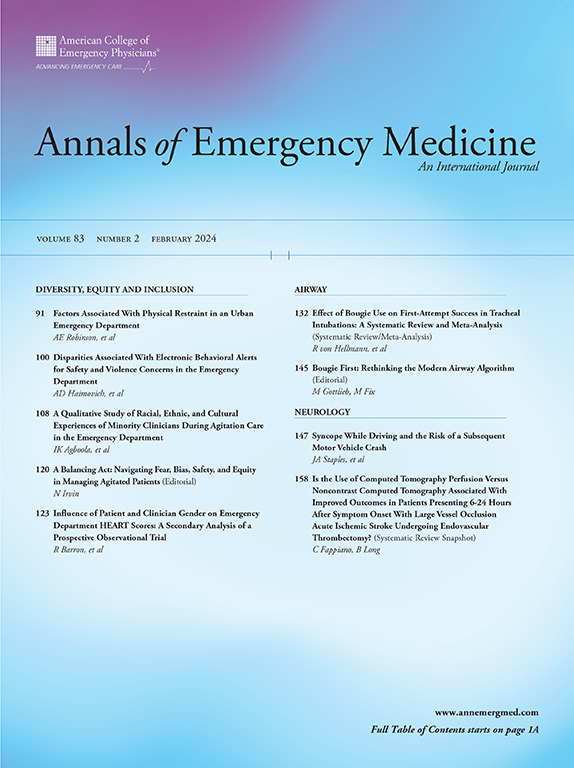Serious Cardiac Outcomes and Physician Estimation of Risk in Emergency Department Patients With Presyncope Versus Syncope.
IF 5
1区 医学
Q1 EMERGENCY MEDICINE
引用次数: 0
Abstract
STUDY OBJECTIVE Previous research suggests that the short-term incidence of adverse events is similar in emergency department (ED) patients with presyncope and syncope. However, admission rates for presyncope are lower, which could imply clinicians underestimate its risk. We sought to compare physician risk estimates and the 30-day rate of serious cardiac outcomes between patients with syncope and presyncope. METHODS We conducted a secondary analysis of a prospective, observational, multicenter study of patients aged ≥40 years presenting to ED with presyncope or syncope. Patients with serious ED diagnoses were excluded. Descriptive statistics and multivariable regression analyses were used to compare the physician-estimated risk, ED disposition, and 30-day rate of adverse outcomes. RESULTS Of the 1,263 patients analyzed, 721 (57%) had syncope and 542 (43%) had presyncope. Baseline characteristics were similar between groups. At 30 days, 34 (4.7%) syncope patients and 28 (5.2%) presyncope patients experienced a serious cardiac outcome; logistic regression showed no difference in the odds (odds ratio 1.13; 95% confidence interval 0.66 to 1.79) of serious cardiac outcomes between syncope and presyncope patients. The mean physician-estimated risk of serious cardiac outcomes was 7.6% in syncope, versus 5.3% in presyncope (risk difference 2.3% [0.89%, 3.7%]); this difference remained significant after adjustment for clinical characteristics. Admission rate was lower in presyncope, 38.2% versus 49.5% (risk difference 11.3% [1.2%, 21.5%]). CONCLUSION Patients with unexplained presyncope and syncope had similar rates of 30-day serious cardiac outcomes after ED visit. Patients with presyncope were less likely to be admitted and had a lower mean physician-estimated risk of adverse outcomes.急诊科晕厥前期与晕厥患者的严重心脏结局和医师风险评估
研究目的以往的研究表明,急诊科(ED)晕厥前期和晕厥患者的短期不良事件发生率相似。然而,晕厥前期的入院率较低,这可能意味着临床医生低估了其风险。我们试图比较晕厥和晕厥前期患者的医生风险评估和30天严重心脏结局发生率。方法:我们对一项前瞻性、观察性、多中心研究进行了二次分析,该研究纳入了年龄≥40岁的ED伴晕厥前期或晕厥的患者。诊断为严重ED的患者排除在外。描述性统计和多变量回归分析用于比较医生估计的风险、ED处置和30天不良结局发生率。结果1263例患者中,721例(57%)有晕厥,542例(43%)有晕厥前期。各组间基线特征相似。在第30天,34例(4.7%)晕厥患者和28例(5.2%)晕厥前期患者出现了严重的心脏结局;Logistic回归显示,晕厥和晕厥前期患者发生严重心脏结局的几率(比值比1.13;95%可信区间0.66 ~ 1.79)无差异。医生估计的晕厥患者发生严重心脏后果的平均风险为7.6%,而晕厥前期为5.3%(风险差异为2.3% [0.89%,3.7%]);在调整临床特征后,这一差异仍然显著。晕厥前期住院率较低,分别为38.2%和49.5%(风险差11.3%[1.2%,21.5%])。结论不明原因的晕厥前期和晕厥患者在急诊科就诊后30天严重心脏事件发生率相似。晕厥前期患者入院的可能性较小,医生估计的不良后果平均风险较低。
本文章由计算机程序翻译,如有差异,请以英文原文为准。
求助全文
约1分钟内获得全文
求助全文
来源期刊

Annals of emergency medicine
医学-急救医学
CiteScore
8.30
自引率
4.80%
发文量
819
审稿时长
20 days
期刊介绍:
Annals of Emergency Medicine, the official journal of the American College of Emergency Physicians, is an international, peer-reviewed journal dedicated to improving the quality of care by publishing the highest quality science for emergency medicine and related medical specialties. Annals publishes original research, clinical reports, opinion, and educational information related to the practice, teaching, and research of emergency medicine. In addition to general emergency medicine topics, Annals regularly publishes articles on out-of-hospital emergency medical services, pediatric emergency medicine, injury and disease prevention, health policy and ethics, disaster management, toxicology, and related topics.
 求助内容:
求助内容: 应助结果提醒方式:
应助结果提醒方式:


